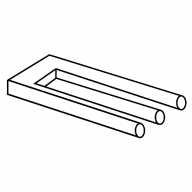Upgrades to Kennedy Ground Systems near completion for Artemis II.
The crew access arm (CAA) has been extended in this view of the mobile launcher on June 13, 2023, at NASAs Kennedy Space Center in Florida. The CAA is the entry and exit point astronauts will use for access to the Orion sp teams with NASA’s Exploration Ground Systems Program at the agency’s Kennedy Space Center in Florida prepare for the first major set of integrated ground system tests for Artemis II, the first crewed mission under Artemis, engineers have nearly completed upgrades to mobile launcher 1 and launch pad 39B.
Technicians repaired the elevators on the mobile launcher, which sustained damage during Artemis I launch, and teams are evaluating ways to harden the elevators and strengthen blast doors ahead of Artemis II. Teams are finishing refurbishing the platform’s blast plates surrounding the mobile launcher’s flame hole to protect it against the powerful exhaust plume from the rocket’s engines. At the pad, personnel are modifying the panels on the flame deflector to account for turbulent exhaust flows observed after the first SLS (Space Launch System) launch.
Teams also are testing the crew access arm, the entry and exit point on the mobile launcher astronauts use for access to the Orion spacecraft. This summer, workers will conduct swing tests of the arm to ensure it and supporting mobile launcher systems are certified to support crewed missions.
Another major upgrade to the mobile launcher ahead of Artemis II is the addition of the emergency egress life safety system. The system provides astronauts and close out crews the ability to safely exit the mobile launcher or Orion in the unlikely event of an emergency during launch countdown. If astronauts and pad personnel need to evacuate, they will proceed to the emergency egress baskets, which are suspended from a catenary system, and travel down to emergency transportation vehicles located at the base of the launch pad. The baskets, which are similar to gondola cars at ski lifts, will be installed on the mobile launcher and tested later this year.
“The emergency egress system is a critical piece supporting the safety of the crew and is dependent on our team being diligent in their work and conducting safe practices,” said Shawn Quinn, Exploration Ground Systems Program manager. “NASA has five core values: safety, integrity, teamwork, excellence, and inclusion. It is no coincidence that safety comes first – the integrity of our work and delivering an emergency egress system are all dependent on our safety values.”
Teams are redesigning the panels on the flame deflector in the flame trench at Launch Pad 39B in this view on June 13, 2023, ahead of the first critical ground testing for Artemis II. The flame deflector withstood damage observed after launch of Artemis I. Artemis II will be the first Artemis mission flying crew aboard Orion.
Teams also have nearly completed the emergency egress system terminus area at pad 39B, where the baskets carrying the astronauts or other personnel will arrive following their safe exit from the mobile launcher in an emergency. Emergency transportation vehicles will be stationed there to take the astronauts and remaining personnel safely away from the launch pad. The terminus area will be completed by the end of this month in preparation for mobile launcher arrival at the pad later this summer for tests.
Other upgrades to pad 39B include completing construction of the additional 1.4-million-gallon liquid hydrogen sphere used for propellant loading. Having two liquid hydrogen spheres at the pad allows teams to minimize time between launch attempts for resupplying liquid hydrogen. Once construction is complete in July, workers will test the new tank by flowing liquid hydrogen to and from it while the mobile launcher is at the pad.
In July, teams also expect to complete the environmental control system at the pad, which provides air supply, thermal control, and pressurization to SLS and Orion. Engineers will demonstrate the system as part of the verification and validation testing.
After the mobile launcher arrives at the launch pad, ground systems teams at Kennedy and the Artemis II crew will conduct a day of launch dry run, including operations for the crew, closeout crew, and the pad rescue team. The test will include being inside crew quarters, putting on their orange Orion Crew Survival System spacesuits, and heading to the launch pad in the new all-electric crew transportation vehicles. Future tests with the crew include demonstrating the end-to-end emergency egress process from the white room – the room inside the mobile launcher’s crew access arm – to the pad evacuation site.
Yeah, baby!


